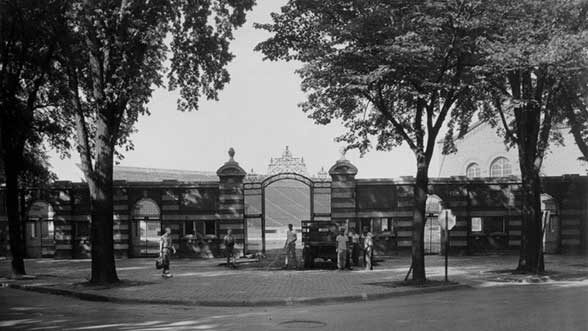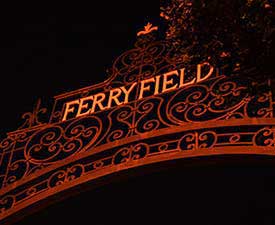The 2015-16 academic year marks the 150th anniversary of Michigan Athletics. The department invites the University of Michigan family to celebrate the passion that fuels us, rediscover the stories and traditions that unite us, and imagine what the future holds for us. We look forward to celebrating “This Michigan of Ours.” To share a memory of Michigan Athletics, please fill out the online form or email goblue150@umich.edu.
Gateway to history
An ornamental wrought-iron gate located off State Street, near the corner of Hoover Avenue, connects academics to athletics at the University of Michigan. It also connects past to present.
That gate to Ferry Field, which became home to the Wolverines’ football team in 1906, was first used by fans the year after Fielding H. Yost’s “Point-a-Minute” teams had completed a 56-game unbeaten streak that included the program’s first four national championships.
The swinging metal gate, standing nearly two stories high, was moved 61 years ago when progress deemed its original location the best spot for new athletic department offices.
The gate, with fleur-de-lis atop its iron bars and a metal pineapple painted yellow welded to its summit, was designed by Albert Kahn at the same time he was beginning to shape the landscape of the University.
“I would categorize the gate as traditional, English-style work,” says Scott Lankton, an Ann Arbor blacksmith artist. “But it’s really hard to categorize because the gate itself is not traditional — it’s Albert Kahn.”
Kahn’s vision
Kahn began with the Engineering Building in 1903 and designed Michigan’s most iconic buildings over a span of 35 years. Angell Hall, the Natural Science Building, General Library, the original University of Michigan Hospital, the Museums Building, Burton Tower, and his personal favorites — Clements Library and Hill Auditorium — all were created and brought to life by Kahn.
The gate may be a minor piece in the current campus layout, but it symbolizes so much. The fleur-de-lis and pineapple invoke heraldry, hospitality, and good luck.
“I’m so glad it’s here, and I want to protect it,” says Carol Kahn, granddaughter of its designer. Her son, Case Kittel, an athlete and senior studying civil engineering, lives in a house less than one block from the gate.
Kittel, who also wrestles at 149 pounds for Michigan’s club wrestling team, beams when surveying its beauty and strength.
“Since I live so close to here,” he says, “I come to Ferry Field to run on the track or go to the (adjoining) Intramural Building. I normally walk right through this gate coming to the track. So, it’s really cool. And that legacy is neat to be a part of.”
The legacy
The Kahns impacted both athletics and academics at Michigan over a stretch of eight decades, and their story is a fitting one to launch the 150th anniversary celebration of the University’s athletic program, which began with a baseball team in 1865.
Carol Kahn’s father is Edgar “Eddie” Kahn, a Wolverines hockey captain who scored the program’s first goal and went on to become a medical pioneer as chief of neurosurgical service at the University of Michigan Hospital — which just happened to be designed by Albert Kahn.The Kahns’ connection to athletics began with Albert’s Ferry Field gateway designed 109 years ago to welcome fans to the new football home of the Wolverines. Detroit businessman and philanthropist Dexter M. Ferry donated the 20 acres where the field was built. Ferry paid $10,000 for the construction of three brick walls to enclose the field and 18,000 seats. The ornamental gate at the corner at State and Hoover was flanked by 10 ticket windows and walls constructed of Bedford stone and red paving bricks.
“FERRY FIELD” was emblazoned near the top of the gate, which provided a sense of grandeur for those attending games there for 21 seasons until the current Michigan Stadium opened in 1927. And those were grand days for the Wolverines, who went 90-13-2 at Ferry with the legendary Yost leading the way in all but one of those seasons.
Field position
Ferry’s walls came down in 1954 to make way for the building of what is now called Weidenbach Hall, where Bo Schembechler had an expansive second-floor office at the south end overlooking the current Ferry Field track and field facility. Yost’s office was on the north side of what is now called the Hartwig Building but was then the Athletic Administration Building. There is a concrete walkway between the two structures, and the relocated Ferry Field gate serves as the entrance to that area, linking the buildings and, in a way, Schembechler and Yost.
Charles Baird, who became Michigan’s first athletic director in 1900, not only oversaw the construction of Ferry Field. He also hired Yost in his first year, setting the tone for greatness later emulated by legendary athletic director Don Canham in landing Schembechler.
Baird in 1936 donated the money for the 55 bells in the Baird Carillon in Burton Tower — designed by Kahn. And so the pioneers of great academic architecture and a superior athletic department crossed paths once more, assuring everything at Michigan became something special, something connected.
(Top image of Ferry Field entrance and gate courtesy of mgoblue.com.)
This story is an edited version of an original piece that ran at mgoblue.com. Read the full version.







Lynn Swanson - 1976
Thank you for this informative and meaningful article. It enhances the imagined adventures and experiences of my aunt and uncle during their years as students there in the early twenties. I can see them walking through the gate on game day and listening to the 55 bells in the tower as they walked to their classes. I enjoyed the connection you brought forward between athletics and aesthetics.
Reply
martin gurvey - '64 BM, '65 MM
Beautifully written.
Reply
Marshall Smith - A.B. 1962, M.S.W. 1963
My father, Ivan C. Smith, B.Ed., 1932, walked through the Ferry Field gate to attend football practice. He joined the team one year after Da Big House opened. He was eventually wooed away from football by Matt Mann, coach of the swimming team, and helped set a relay record which still stands (essentially because the size of pools and the distances of events changed). Nonetheless, Michigan football was always in his consciousness. He would be sure to lead me through the gate whenever we visited campus – usually before a Saturday game, as I have continued to do with my now grown children and my grandchildren.
Reply
robert arthur - '77
Such a beautiful metal gate, originally flanked by multiple articulated masonry piers to create such a majestic entrance, has now been sadly relegated to a meaningless spot on State Street amid an architectural trainwreck of the ever-expanding athletic mega-complex. The main gates barely have room to fully open, the smaller side gate panels have been eliminated or permanently welded shut, and once through the gated opening, one is wedged into a claustrophobic mouse hole passage where the axial intent of the arched opening has been fully violated.
It appears that soon, this will become the gate to nowhere. According to the current Wikipedia entry:
“Following the 2015 men’s and women’s outdoor track & field season, Ferry Field will be demolished and turned into a parking lot for sports surrounding the area.”
Uhhhh…….Go Blue?
Reply
Joanna Connelly - 2013
I am similarly distressed by the impending destruction of Ferry Field, and a legacy lost.
Reply
Peter Manni - 1963
Great article; a reminder of the history embodied by such seemingly everyday items like a gate or a quadrangle or a building all of which were part of the fabric of being at Michigan.
Reply
Lucy Oakley-Mitchell - 1965
As a graduate of the school of A & D I want to challenge the dean to LEAD an initiative to preserve these gates of historical value. When I was an undergraduate student, we were assigned problems of preserving and transforming actual buildings on or near campus. Perhaps a similar assignment could engage current A & D students to do the same with the Kahn gates.
This is about more than just bricks and mortar. This about what Michigan students (past and present) hold dear in their psyche regarding their university experience. Be the institutional champions you claim to be and preserve the symbols of ” the victors valiant”
Reply